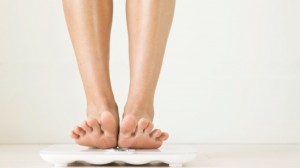 A surprising new strategy for managing your weight? Bright morning light!! A new Northwestern Medicine® study reports the timing, intensity and duration of your light exposure during the day is linked to your weight -- the first time this has been shown.
A surprising new strategy for managing your weight? Bright morning light!! A new Northwestern Medicine® study reports the timing, intensity and duration of your light exposure during the day is linked to your weight -- the first time this has been shown.People who had most of their daily exposure to even moderately bright light in the morning had a significantly lower body mass index (BMI) than those who had most of their light exposure later in the day, the study found. “The earlier this light exposure occurred during the day, the lower individuals’ body mass index,” said co-lead author Kathryn Reid, research associate professor of neurology at Northwestern University Feinberg School of Medicine. “The later the hour of moderately bright light exposure, the higher a person’s BMI.”
The influence of morning light exposure on body weight was independent of an individual’s physical activity level, caloric intake, sleep timing, age or season. It accounted for about 20 percent of a person’s BMI.
“Light is the most potent agent to synchronize your internal body clock that regulates circadian rhythms, which in turn also regulate energy balance,” said study senior author Phyllis C. Zee, M.D. “The message is that you should get more bright light between 8 a.m. and noon.” About 20 to 30 minutes of morning light is enough to affect BMI.
Zee is the Benjamin and Virginia T. Boshes Professor of Neurology and director of the Northwestern Medicine Sleep and Circadian Rhythms Research Program at Northwestern University Feinberg School of Medicine. She also is a neurologist at Northwestern Memorial Hospital.
“If a person doesn’t get sufficient light at the appropriate time of day, it could de-synchronize your internal body clock, which is known to alter metabolism and can lead to weight gain,” Zee said. The exact mechanism of how light affects body fat requires further research, she noted.
The study was published April 2 in the journal PLOS ONE. Giovanni Santostasi, a research fellow in neurology at Feinberg, also is a co-lead author.
What’s the Magic Number for Low BMI?
Many people do not get enough natural light in the morning, Zee said, because the American lifestyle is predominantly indoors. We also work in poorly lit environments, usually about 200 to 300 lux. In the study, 500 lux was “the magic number” or minimum threshold for having a lower BMI. Even on a cloudy day, outdoor light is more than 1,000 lux of brightness. It is difficult to achieve this light level with usual indoor lighting, the scientists noted.
Light May Be Next Frontier for Weight Loss
“Light is a modifiable factor with the potential to be used in weight management programs,” Reid said. “Just like people are trying to get more sleep to help them lose weight, perhaps manipulating light is another way to lose weight.”
The study included 54 participants (26 males, 28 females), an average age of 30. They wore a wrist actigraphy monitor that measured their light exposure and sleep parameters for seven days in normal-living conditions. Their caloric intake was determined from seven days of food logs.
Source: Northwestern News Service, author Marla Paul

 With the recent controversy surrounding Rachel Frederickson’s extreme weight loss on The Biggest Loser, it’s time to shed light on the proper (and safe) way to lose weight. For those unfamiliar with reality television, The Biggest Loser centers around overweight contestants attempting to lose weight to win a cash prize. The winner, whoever loses the highest percentage of weight, is given the title “the Biggest Loser,” along with a cool cash prize of a quarter million dollars. This past season’s winner, Rachel Frederickson, has stirred up much press when she dropped 60% of her bodyweight, going from an original weight of 260 lbs. down to a meager 105 in roughly 7 months—a new record for the show.
With the recent controversy surrounding Rachel Frederickson’s extreme weight loss on The Biggest Loser, it’s time to shed light on the proper (and safe) way to lose weight. For those unfamiliar with reality television, The Biggest Loser centers around overweight contestants attempting to lose weight to win a cash prize. The winner, whoever loses the highest percentage of weight, is given the title “the Biggest Loser,” along with a cool cash prize of a quarter million dollars. This past season’s winner, Rachel Frederickson, has stirred up much press when she dropped 60% of her bodyweight, going from an original weight of 260 lbs. down to a meager 105 in roughly 7 months—a new record for the show. A recent study published by researchers at Duke University highlighted the fact that some populations of women are more receptive to weight-management interventions than programs advertising weight loss. Weight loss is difficult across all populations and many programs aimed at reducing the pounds may end up providing only a temporary reprieve. As weight gain and obesity are ever-increasing concerns, some researchers have tried to tackle this problem from another angle. Instead of designing weight loss programs, health enthusiasts should focus on weight management initiatives for certain populations.
A recent study published by researchers at Duke University highlighted the fact that some populations of women are more receptive to weight-management interventions than programs advertising weight loss. Weight loss is difficult across all populations and many programs aimed at reducing the pounds may end up providing only a temporary reprieve. As weight gain and obesity are ever-increasing concerns, some researchers have tried to tackle this problem from another angle. Instead of designing weight loss programs, health enthusiasts should focus on weight management initiatives for certain populations. It is no wonder why the weight-loss industry is a $20 billion per year industry. Dieters spend money on diet books, diet drugs and weight-loss surgery. 108 million people in the United States are on diets and typically attempt four or five diets a year. 85% of dieters are women.
It is no wonder why the weight-loss industry is a $20 billion per year industry. Dieters spend money on diet books, diet drugs and weight-loss surgery. 108 million people in the United States are on diets and typically attempt four or five diets a year. 85% of dieters are women. The FDA recently approved the first weight-loss drug, Belviq (lorcaserin hydrochloride), in 13 years. Arena Pharmaceuticals of San Diego developed the pill to help people lose 3-4% of their body weight when coupled with exercise and a healthy diet. The FDA approved the pill for obese people (BMI over 30) and some overweight people (BMI over 27) who suffer from high blood pressure, high cholesterol, and type 2 diabetes.
The FDA recently approved the first weight-loss drug, Belviq (lorcaserin hydrochloride), in 13 years. Arena Pharmaceuticals of San Diego developed the pill to help people lose 3-4% of their body weight when coupled with exercise and a healthy diet. The FDA approved the pill for obese people (BMI over 30) and some overweight people (BMI over 27) who suffer from high blood pressure, high cholesterol, and type 2 diabetes. Simply ejecting your rear from the couch means your hand will spend less time digging into a bag of chocolate chip cookies.
Simply ejecting your rear from the couch means your hand will spend less time digging into a bag of chocolate chip cookies. Recently Miley Cyrus has been touting a gluten free diet as a way to lose weight. Is this true or just another celebrity fad? Gluten is a protein present in foods including wheat, rye, oats, and barley but may also be found in everyday products such as medicines, vitamins, and even lip balms. There's absolutely nothing wrong with eating gluten unless you have celiac disease, or gluten sensitive enteropathy (GSE), an autoimmune disease that damages the small intestine and interferes with absorption of nutrients from food. If you are sensitive to gluten, the body produces an abnormal immune response to it, attacking the lining of small intestine where digestion takes place. This leads to the symptoms of celiac disease: • abdominal bloating and pain • chronic diarrhea • vomiting • constipation • pale, foul-smelling, or fatty stool • weight loss About 1% of the population has GSE. But there may be another 9% or so who have what is called gluten sensitivity or gluten intolerance. These people may have similar symptoms to those with GSE but do not show the same damage to the bowel as those with GSE. The only treatment for celiac disease is a lifelong, gluten-free diet. But can it cause you to lose weight? The answer is complicated. Studies have shown that patients with GSE who were underweight gained weight on a gluten-free diet. Those with GSE and obesity tended to lose weight after starting a gluten-free diet. What about people who don't have GSE? Celebrities have touted a gluten-free diet as a way to lose weight. Proponents hype it as a healthier way to eat. They claim it improves sleep, increases energy, and clears skin. Some go so far as to say it helps those with autism and rheumatoid arthritis. But Dee Sandquist, MS, RD, a spokeswoman for the Academy of Nutrition and Dietetics, who also happens to have celiac disease, says: There is nothing magical about eliminating gluten that will improve your health or enhance weight loss unless you are intolerant to gluten. The academy points out that "Research on individuals with celiac disease reports that long-term compliance with a gluten-free dietary pattern improves outcomes related to bone density, iron deficiency anemia, villous atrophy, gastrointestinal and neurological symptoms, pregnancy outcomes and quality of life." One problem is the fact that many people with GSE don't even know that they have the disease, and those with gluten intolerance are less likely to be diagnosed. Researchers conclude that there is no scientific evidence supporting the alleged benefit that a gluten-free diet will promote weight loss and that adherence to the gluten-free dietary pattern may actually result in a diet that is low in carbohydrates, fiber and important vitamins. Many confuse a gluten-free diet with a low-carb diet (which can promote weight loss). A gluten-free diet eliminates foods such as bread and pasta, it doesn't eliminate other high-carb foods such as rice, beans and corn. The popularity of gluten-free diets has lead to an explosion of gluten-free food availability and a financially growing industry that is expected to exceed $5 billion by 2015! This is great if you need to be on the diet. However, people need to be aware that these are not low-calorie foods! Some prepared foods have additional fat and sugar added and mixed into substitute flours such as white rice flour or potato starch to make them more palatable. A gluten-free diet is not a panacea for weight loss. It is, however, an important diet for those who suffer from GSE or intolerance.
Recently Miley Cyrus has been touting a gluten free diet as a way to lose weight. Is this true or just another celebrity fad? Gluten is a protein present in foods including wheat, rye, oats, and barley but may also be found in everyday products such as medicines, vitamins, and even lip balms. There's absolutely nothing wrong with eating gluten unless you have celiac disease, or gluten sensitive enteropathy (GSE), an autoimmune disease that damages the small intestine and interferes with absorption of nutrients from food. If you are sensitive to gluten, the body produces an abnormal immune response to it, attacking the lining of small intestine where digestion takes place. This leads to the symptoms of celiac disease: • abdominal bloating and pain • chronic diarrhea • vomiting • constipation • pale, foul-smelling, or fatty stool • weight loss About 1% of the population has GSE. But there may be another 9% or so who have what is called gluten sensitivity or gluten intolerance. These people may have similar symptoms to those with GSE but do not show the same damage to the bowel as those with GSE. The only treatment for celiac disease is a lifelong, gluten-free diet. But can it cause you to lose weight? The answer is complicated. Studies have shown that patients with GSE who were underweight gained weight on a gluten-free diet. Those with GSE and obesity tended to lose weight after starting a gluten-free diet. What about people who don't have GSE? Celebrities have touted a gluten-free diet as a way to lose weight. Proponents hype it as a healthier way to eat. They claim it improves sleep, increases energy, and clears skin. Some go so far as to say it helps those with autism and rheumatoid arthritis. But Dee Sandquist, MS, RD, a spokeswoman for the Academy of Nutrition and Dietetics, who also happens to have celiac disease, says: There is nothing magical about eliminating gluten that will improve your health or enhance weight loss unless you are intolerant to gluten. The academy points out that "Research on individuals with celiac disease reports that long-term compliance with a gluten-free dietary pattern improves outcomes related to bone density, iron deficiency anemia, villous atrophy, gastrointestinal and neurological symptoms, pregnancy outcomes and quality of life." One problem is the fact that many people with GSE don't even know that they have the disease, and those with gluten intolerance are less likely to be diagnosed. Researchers conclude that there is no scientific evidence supporting the alleged benefit that a gluten-free diet will promote weight loss and that adherence to the gluten-free dietary pattern may actually result in a diet that is low in carbohydrates, fiber and important vitamins. Many confuse a gluten-free diet with a low-carb diet (which can promote weight loss). A gluten-free diet eliminates foods such as bread and pasta, it doesn't eliminate other high-carb foods such as rice, beans and corn. The popularity of gluten-free diets has lead to an explosion of gluten-free food availability and a financially growing industry that is expected to exceed $5 billion by 2015! This is great if you need to be on the diet. However, people need to be aware that these are not low-calorie foods! Some prepared foods have additional fat and sugar added and mixed into substitute flours such as white rice flour or potato starch to make them more palatable. A gluten-free diet is not a panacea for weight loss. It is, however, an important diet for those who suffer from GSE or intolerance. Women typically find it harder to lose weight and inches than men. This, in part, is due to the fact that men have more lean muscle mass and a higher resting metabolic rate. Another issue that makes weigh loss challenging for females: women store fat differently from men--more of it goes to their thighs, buttocks, and hips, where it can be harder to shed. Finally, female hormones promote the storage of calories as fat, and fat takes up more space than muscle.
Women typically find it harder to lose weight and inches than men. This, in part, is due to the fact that men have more lean muscle mass and a higher resting metabolic rate. Another issue that makes weigh loss challenging for females: women store fat differently from men--more of it goes to their thighs, buttocks, and hips, where it can be harder to shed. Finally, female hormones promote the storage of calories as fat, and fat takes up more space than muscle. The Food and Drug Administration (FDA) and the Federal Trade Commission said over-the-counter weight loss products containing human chorionic gonadotropin (HCG) are fraudulent and illegal, and the agencies have told seven manufacturers to stop selling them. They have become a popular but fraudulent fad.
The Food and Drug Administration (FDA) and the Federal Trade Commission said over-the-counter weight loss products containing human chorionic gonadotropin (HCG) are fraudulent and illegal, and the agencies have told seven manufacturers to stop selling them. They have become a popular but fraudulent fad.
